#center for renewing america
Text

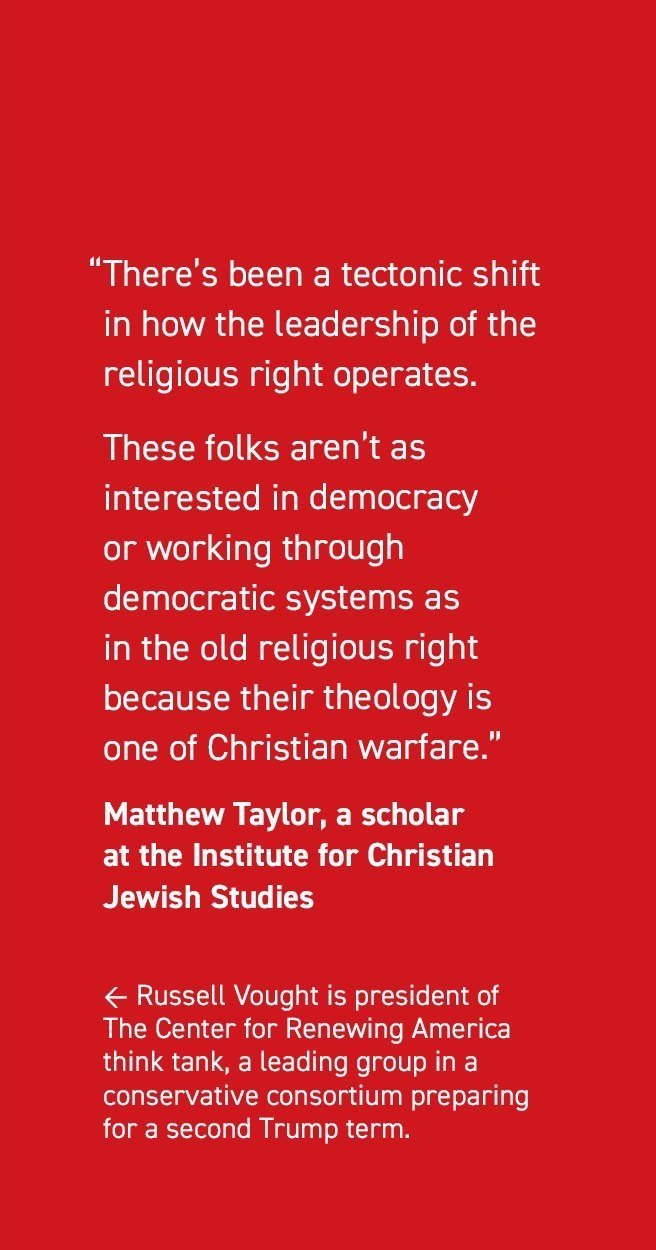
An influential conservative think tank close to Donald Trump is developing plans to infuse Christian nationalist ideas in his administration if the former president returns to power, according to documents that we obtained.
Spearheading the effort is Russell Vought, president of the Center for Renewing America (CRA). He’s rumored to be a potential chief of staff if Trump returns to the White House. Vought – who served in Trump’s first admin – has remained close to the former president and hopes to elevate Christian nationalism as a focal point in a potential second term, according to two people familiar with the plans, who were granted anonymity to discuss internal matters.
One document drafted by CRA includes a list of top priorities for a second Trump term, including “Christian nationalism,” invoking the Insurrection Act on Day One to quash protests and refusing to spend authorized congressional funds on unwanted projects, a practice banned by lawmakers in the Nixon era.
Vought also:
➡️ has said immigration requirements should include whether that person “accept[ed] Israel’s God, laws and understanding of history”
➡️ has a close affiliation with Christian nationalist William Wolfe, a former Trump admin official who has advocated for overturning same-sex marriage, ending abortion and reducing access to contraceptives
➡️ is advising the Heritage Foundation’s Project 2025, which would usher in one of the most conservative executive branches in modern American history. Proposals include repealing LGBTQ+ rights, increasing abortion surveillance and defunding Planned Parenthood.
Meanwhile, CRA is already influencing Trump’s positions. His thinking on withdrawing the U.S. from NATO and using military force against Mexican drug cartels is partly inspired by separate CRA papers, according to reports by Rolling Stone.
Trump’s campaign has repeatedly insisted that it alone is responsible for putting together a policy platform and staffing for a future administration. They declined to comment. So did Vought.
x
so many people claim that voting for biden would somehow be immoral given what's happening in gaza, but what these people fail to realize is that there are numerous issues at play. biden is at the top of the hill of shittiness; however, at the same time, we simply cannot allow what the right has planned to be carried out. it would not help gaza, and it would surely make life here worse for everyone, including those who want to see a free palestine.
#conservative think tank#christian nationalism#trump administration#russell vought#center for renewing america#christian values#political strategy#white house plans#christian right#us politics#presidential agenda#political priorities#religious influence#us government#conservative politics#trump agenda#government strategy#christian politics#political planning#political ideology.#gaza#israel#palestine#politics#joe biden#biden#03042024
4 notes
·
View notes
Text
The Best News of Last Week - November 28, 2023
🐑 - Why did Fiona the sheep become a mountaineer? She was tired of the "baa-d" jokes at sea level!
1. Pope Francis dines with transgender women for Vatican luncheon
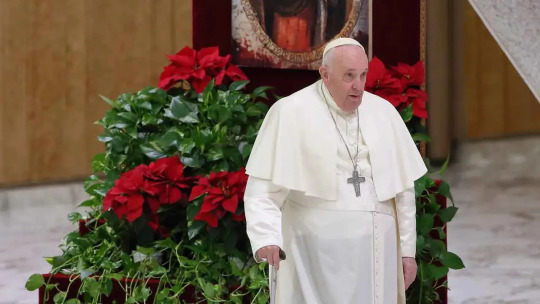
Pope Francis hosted a group of transgender women — many of whom are sex workers or migrants from Latin America — to a Vatican luncheon for the Catholic Church's "World Day of the Poor" last week.
The pontiff and the transgender women have formed a close relationship since the pope came to their aid during the COVID-19 pandemic, when they were unable to work. Now, they meet monthly for VIP visits with the pope and receive medicine, money and shampoo any day, according to The Associated Press.
2. New York just installed its first offshore wind turbine

The first wind turbine installation at South Fork Wind, New York State’s first offshore wind farm, is complete.
The 130-megawatt (MW) South Fork Wind will be the US’s first completed utility-scale wind farm in federal waters.
3. Anonymous businessman donates $800k to struggling food bank
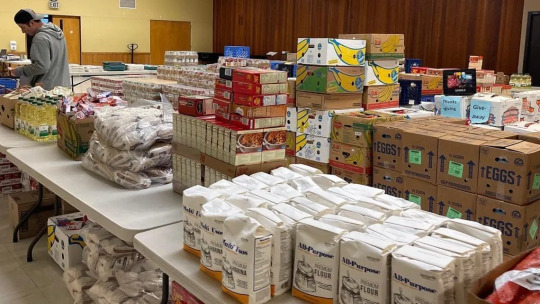
But this Thanksgiving, a longtime prayer of food bank leaders was finally answered: an anonymous benefactor donated the full $800,000 they needed to move out of a facility they've long outgrown. That benefactor, however, preferred to stay anonymous.
"Very private company, really don't want attention," said Debbie Christian, executive director of the Auburn Food Bank. "It's a goodhearted person that just wants to see the work here continue, wants to see it expand."
4. Empowering woman saving hopes and mental health of suffering Ukrainian kids

Kenza Hadij-Brahim is at the forefront of promoting Circle of Toys
Hadj-Brahim is helping to launch the Circle of Toys initiative. A project that provides Ukrainian children in need of some normality with preloved toys. This new initiative connects people with old toys they might otherwise throw away, with Ukrainian families in need who want to provide some comfort to their children in this distressing time.
Find Refuge said : “The endeavour is driven by a sincere purpose: spark joy, foster play, and bring a hint of normalcy back to the young lives in Ukraine.”
5. TWO LOST CITIES HIDDEN FOR CENTURIES WERE JUST DISCOVERED IN BOLIVIA
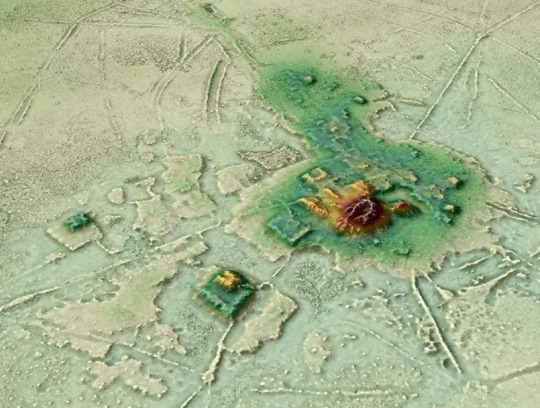
Researchers have found these areas not only housed structures and pyramids but it has been uncovered that there were advanced irrigation systems, earthworks, large towns, causeways, and canals that cover miles.
Dr. Heiko Prümers from the German Archaeological Institute, who was also involved in the study comments that “this indicated a relatively dense settlement in pre-Hispanic times. Our goal was to conduct basic research and trace the settlements and life there. The research sheds light on the sheer magnitude and magnificence of the civic-ceremonial centers found buried in the forest”.
6. Sheep dubbed Fiona rescued from cliff in Scotland where she was stuck for more than 2 years
youtube
And at last, some positive climate news:
7. Three positive climate developments
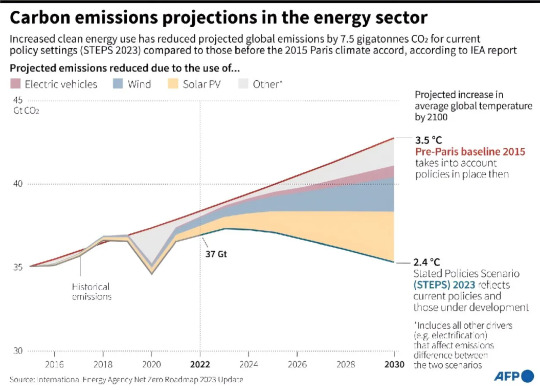
Heating
When the Paris Agreement was adopted, the global reliance on fossil fuels placed the world on a path towards a 3.5C rise in temperature by 2100. Eight years on, country commitments to reduce their carbon footprints have pulled that down slightly, putting the world on a path for a 2.5C to 2.9C by the end of the century.
Peak emissions
Annual greenhouse gas emissions responsible for climate change have risen roughly nine percent since COP21, according to UN data. But the rate of the increase has slowed significantly. Recent estimates by the Climate Analytics institute find global emissions could peak by 2024
Rising renewables
Three technologies—solar, wind and electric vehicles—are largely behind the improved global warming estimates since 2015.
---
That's it for this week :)
This newsletter will always be free. If you liked this post you can support me with a small kofi donation here:
Buy me a coffee ❤️
Also don’t forget to reblog this post with your friends.
812 notes
·
View notes
Text
Things Biden and the Democrats did, this week #4
Feb 2-9 2024
The White House announced that a landmark 23 million Americans, 1 in 6 households, have been connected to affordable high speed internet with the help of the Affordable Connectivity Program, saving Americans between $30 and $75 every month on their internet bill. 4 Million ACP users are seniors, 1/4th of households on the program are African American and 1/4th are Latino, and it supports 320,000 households on Tribal lands. Sadly the program will be forced to end if Republicans in Congress continue to block new funding
The White House announced $5 billion for a National Semiconductor Technology Center, focusing on research and development as well as workforce needs. This is part of an effort under the CHIPS and Science Act to make America a world leader in science and grow jobs for the 21st century. This will include hundreds of millions of dollars of investment in workforce development
The EPA announced finalized rules that will strength air quality standard around fine particle pollution, AKA soot. The new stronger rules are projected to prevent 4,200 premature deaths and save Americans $46 billion in health costs by 2032. Soot is particularly harmful to those with lung and heart illnesses, children and those with asthma. Industrial soot is more common in low income communities
The Department of Transportation announced $1.5 Billion investment in America's bus systems. The bulk of the money will go helping local transport authorities buy low or no emission buses. There will also be investment in bus facilities.
President Biden signed a memorandum directing a strengthening of human rights safe guards around weapons transferred from US stockpiles to allied nations. The directive seeks to guarantee no arms are transferred that might be used to violate human rights.
HHS and HUD announced a join program partnering with 8 states and DC to help streamline an all of government response to homelessness. This is an off shoot of the $3.16 billion dollar investment amounted by HUD last week to end homelessness in America
The Department of Energy and FEMA released the findings of a two year study that projections Puerto Rico will be able to be 100% renewable energy by 2050. DoE also announced that by the end of the 30,000 low income Puerto Ricans will be able to apply for a solar power program, the first investments in a billion dollar DoE program for the island's renewable energy future
Department of Transportation announced $417 million dollar loan to the North Carolina Turnpike Authority to complete a major transportation overhaul in the greater Raleigh area
The EPA and Department of Energy announced a joint plan to invest federal funds to help measure and reduce methane emissions from the oil and gas production. Methane is the second largest green house gas after CO2 and is responsible for 30% of global warming in the last 200 years. This comes after the EPA pushed new rules to fine oil and gas manufacturers for excess methane emissions.
The Senate confirmed 2 more Biden nominated federal judges. This brings the total number of Biden judges to 177 For the first time in history a majority of a President's judicial nominees are not white men, Biden has nominated a majority women and people of color Biden also nominated 4 more federal judges, including two LGBT candidates. If they are confirmed it'll bring Biden's LGBT judge total to 11 tying with President Obama for the most LGBT people put on the federal bench
#Joe Biden#Thanks Biden#democrats#good news#politics#us politics#climate change#climate crisis#public transport#buses#puerto rico#clean energy
370 notes
·
View notes
Text
The US extended its claims on the ocean floor by an area twice the size of California, securing rights to potentially resource-rich seabeds at a time when Washington is ramping up efforts to safeguard supplies of minerals key to future technologies.
The so-called Extended Continental Shelf covers about 1 million square kilometers (386,100 square miles), predominantly in the Arctic and Bering Sea, an area of increasing strategic importance where Canada and Russia also have claims. The US has also declared the shelf’s boundaries in the Atlantic, Pacific and Gulf of Mexico.[...]
Under international law, countries have economic rights to natural resources on, and under, the seabed floor based on the boundaries of their continental shelves.
“It’s a huge deal because it’s a huge amount of territory,” said Rebecca Pincus, director of the Polar Institute at the Wilson Center in Washington, which has devoted an entire web page to the ramifications of this week’s news. “It’s US sovereignty over the seabed floor, and so whether it’s seabed mining, or oil and gas leasing, or cables, or what have you, the US is announcing the borders of its ECS and will have sovereignty over those decisions.”
The US State Department said that the development “is about geography, not resources.”[...]
While it’s unclear what materials, if any, can be exploited, the claims come as Washington seeks to boost access to so-called critical minerals that are necessary for electric vehicle batteries and renewable energy projects, industries the Biden administration has tagged as key national security concerns.[...]
More than half of America’s extended continental shelf — 520,400 square kilometers — stretches in a large wedge north of Alaska toward the Arctic Ocean, including an area that overlaps with Canadian claims to the seabed floor, according to the US statement.
Another 176,300 square kilometers lies in the Bering Sea, between Alaska and Russia, but falls on the US side of the maritime boundary between the two countries. Canada and the US don’t have a maritime boundary agreement in the Arctic and establishing the US outer limits in the Arctic “will depend on delimitation with Canada,” the State Department said in its executive summary.
Canada’s Ministry of Foreign Affairs didn’t respond to a request for comment. [...]
The decision to unilaterally delineate its continental shelf boundary, rather than to ratify UNCLOS and then submit a claim through the commission, may raise the ire of other countries, said Pincus at the Wilson Center.
“I think a lot of other countries around the world are going to have thoughts about how the US has done this,” she said. It also may reduce the likelihood of the US ever ratifying the law since a major reason for doing so would have been to make a CLCS claim, she said.
23 Dec 23
54 notes
·
View notes
Note
I have been curious about Elizabeth Goudge for quite a time now (thanks to you), but of course I don't have easy access to her works, so I was wondering if you could write some sort of orientation of how to navigate her stories, which are to be preferred first, etc? Mostly interested in her non-children-oriented books (nothing against the thing per se, I just have a harder time with it).
I don't have easy access to her work either, so I've mostly just read from among the handful of books that happen to be on hoopla.
Of the ones I've read, The Dean's Watch and The Rosemary Tree are by far my favorites. Life-changing literature for me.
The Dean's Watch is set in a Victorian cathedral town, and is about a developing friendship between the dean of a cathedral and a master clockmaker, and how it transforms various relationships. I can't get any more specific than that, but it's a very, very Advent book.
The Rosemary Tree centers around a newly-released prisoner coming to an English country town, getting work as a gardener, and getting entangled in the lives of the local priest's family and some schoolteachers. It's very much a springtime book, all about growth, repentance, forgiveness, renewal, and second chances.
Green Dolphin Street is perhaps her best known book (of her adult work), about a man who meets two sisters and later accidentally marries the wrong one. I've only read part of it so far, and did like what I read. Note that the people who have finished it call it a masterpiece and also emotionally devastating.
The Elliot trilogy is also fairly well-known saga about a family in a country town. I've read the second and third books. The second is titled either The Herb of Grace or Pilgrim's Inn depending on if you're in America or Britain, and it's about a young family buying and restoring a house that was one a medieval inn. It is absolutely peak cottagecore. The Heart of the Family follows the family post-WWII as a concentration camp survivor comes there to find healing, and the main couple heals their marriage. I liked the former book more than the latter, but they're both excellent examples of Goudge style, if not as transcendant as some of the others.
The only other book of hers I've read so far is The Scent of Water, and to be honest, I remember nothing about it. It's very much in her style of nature + family + poetic writing + spiritual revelations, but I can't for the life of me tell you what the plot was.
That's about all the guidance I can offer you on her works. There are a lot of people who are a lot more widely read in her works than I am (@teabooksandsweets is the local expert, who doesn't seem to be around lately, but maybe checking her blog could be a better starting point.)
#answered asks#elizabeth goudge#thatscarletflycatcher#pilgrim's inn#the heart of the family#the dean's watch#the rosemary tree#sorry if this isn't what you were looking for#but unfortunately 'reviews of what i've read' are all i can offer
26 notes
·
View notes
Text
Challenges and Solutions in Deforestation in the US
The United States of America, known for its geographical diversity and vast expanses of natural landscapes, finds itself at the center of a significant environmental challenge: deforestation. Often overshadowed by global debates about tropical forest loss, deforestation in the United States is a critical issue that warrants renewed attention. In this article, we will explore the complex reality of deforestation in this country, examining its causes, consequences, and innovative solutions being developed to preserve the valuable forests of the United States. From the vast forests of the Pacific Northwest to the woodlands of the Appalachians, the challenge of deforestation in the United States transcends geographical borders and calls upon us to take meaningful action to safeguard our natural resources and the future of our planet.
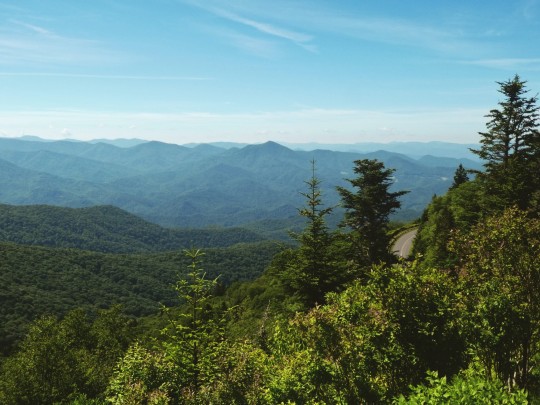
Current Situation of Deforestation in the US
Deforestation in the United States has been a cause for concern for decades. Despite vast forested areas in the country, there is constant pressure on these ecosystems. Below are some key aspects of the current situation of deforestation in the United States:
Loss of Natural Habitat: One of the most noticeable effects of deforestation in the United States is the loss of natural habitat for wildlife. As forests are cleared for urban expansion, agriculture, and industry, many animal and plant species are threatened or displaced.
Climate Change: Forests play a crucial role in carbon capture and climate regulation. Deforestation contributes to climate change by releasing large amounts of carbon stored in trees and forest soil.
Water Quality Effects: Forest clearing can affect the quality of water in nearby rivers and streams. Trees play an important role in filtering contaminants and stabilizing water flow.
Loss of Natural Resources: Deforestation also results in the loss of important natural resources, such as timber. Without sustainable management, forest exploitation can deplete these resources irreversibly.
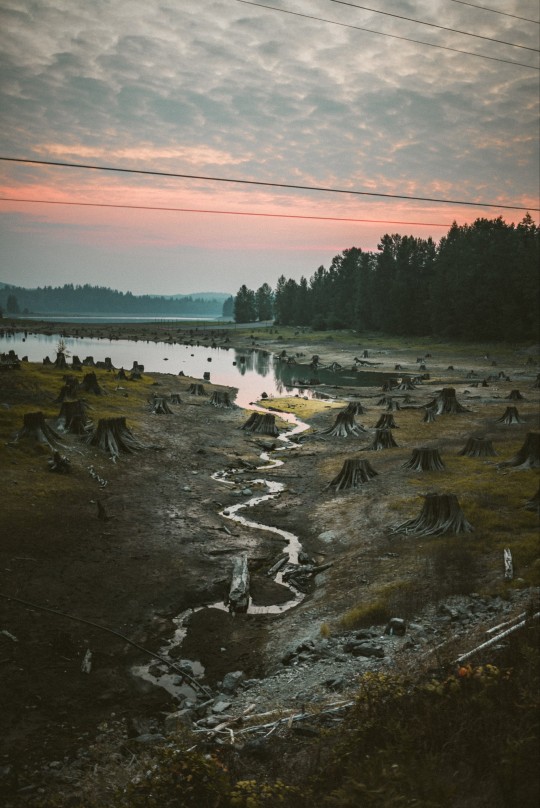
Proposals to Address Deforestation
Given the importance of forests in global health and people's quality of life, it is crucial to take action to address deforestation in the United States. Below are some proposals to tackle this problem:
Promote Sustainable Forestry: Promoting sustainable forest management is essential to ensure that U.S. forests are not overexploited. This involves implementing responsible logging practices that allow for forest regeneration and biodiversity conservation.
Ecosystem Restoration: Investing in the restoration of degraded ecosystems can help reclaim areas that have been deforested in the past. This includes planting native trees and restoring natural habitats.
Protection of Sensitive Areas: Identifying and protecting ecologically valuable areas is crucial. Creating natural reserves and national parks contributes to the conservation of intact ecosystems and biodiversity preservation.
Education and Awareness: Public education about the importance of forests and the impacts of deforestation can encourage informed decision-making and citizen involvement in forest conservation.
Effective Policies and Regulations: Strengthening and enforcing laws and regulations related to tree felling is essential. This includes implementing measures to prevent illegal logging and ensure the sustainability of forest exploitation.
Economic Incentives: Providing economic incentives to businesses and landowners who adopt sustainable forestry practices can be an effective strategy to reduce deforestation.

Conclusion
Deforestation in the United States is a problem that requires ongoing attention and decisive action. Forest loss not only has local impacts but also affects the globe by contributing to climate change and biodiversity loss. To protect our natural resources and ensure a sustainable future, it is essential to effectively address this challenge through sustainable forest management, ecosystem restoration, and public awareness. Only through a comprehensive and collaborative approach can we preserve the valuable forests of the United States for future generations.
Thanks for reading!
-WildTrail team
#deforestation#forest#climate change#pollution#awareness#conciousness#education#nature blog#nature lover#nature#new post#text post#text#reading#read#natural resources#follow#txt post#txt#share#article#social issues#social
42 notes
·
View notes
Text

North Carolina’s Republican-controlled House passed a previously vetoed proposal Wednesday to restrict how teachers can discuss certain racial topics that some lawmakers have equated to “critical race theory.”
The House voted 68-49 along party lines for legislation to ban public school teachers from compelling students to believe they should feel guilty or responsible for past actions committed by people of the same race or sex.
United in their opposition, House Democrats challenged Republican claims that the bill would reduce discrimination and argued that a comprehensive history education should make students uncomfortable.
Republican seat gains in the midterm elections give them greater leverage this year to override any veto by Democratic Gov. Roy Cooper, who blocked a similar proposal in 2021 and urged legislators this month in his State of the State address, “Don’t make teachers re-write history.” But Republicans, who are one seat short in the House of a veto-proof supermajority, will likely need some Democratic support for the measure to become law.
North Carolina is among 10 states considering such proposals, according to an Education Week analysis. Eighteen others have already limited how teachers can discuss racism and sexism in the classroom.
Gaston County Republican Rep. John Torbett said the proposal, which now heads to the Senate, would prohibit schools from endorsing controversial concepts, including that one race or sex is inherently superior.
“This great education state must have an educational system that unites and teaches our children, not divides and indoctrinates them,” said Torbett, the bill’s sponsor.
Several Democrats, including Reps. Rosa Gill of Wake County and Laura Budd of Mecklenburg County, raised concerns that the language is vague and does not outline clear boundaries for teachers. Budd said this “massive failure” places unnecessary pressure on teachers who may feel like they need to stifle productive classroom discussions to keep their jobs.
“The bill, on its face, is the obvious attempt to micromanage from the General Assembly into the classrooms,” she said during floor debate. “It’s overreach and will have a chilling effect on teachers and educators in curtailing what they think they’re allowed to teach.”
Republican lawmakers in committee had applauded the measure for “banning” critical race theory, a complex academic and legal framework that centers on the idea that racism is embedded in the nation’s systems and institutions that perpetuate inequality.
The bill does not explicitly mention the framework, but it would prohibit teaching that the government is “inherently racist” or was created to oppress people of another race or sex. Its language mirrors a model proposal from Citizens for Renewing America, a conservative social welfare group founded by a former Trump administration official to rid the nation’s schools of critical race theory.
Republicans nationwide have spun the phrase into a catchall for racial topics related to systemic inequality, inherent bias and white privilege. While many K-12 public schools teach about slavery and its aftermath, education officials have found little to no evidence that critical race theory, by definition, is being taught.
North Carolina schools would also be required under the bill to notify the state’s Department of Public Instruction and publish information online at least a month before they plan to host a diversity trainer or a guest speaker who has previously advocated for the beliefs restricted by the legislation.
Cary mother and activist Michelle O’Keefe was among several parents who testified against the bill in a Tuesday committee meeting. O’Keefe said she doesn’t want her young child sheltered from learning about racism and other atrocities in history, as long as those lessons are age-appropriate.
“The best way to keep history from repeating itself,” she said, “is to know the history.”
Another mother worried she could be banned from speaking at her child’s school career day because she has a documented history of speaking out against social injustices. Democratic Rep. Julie von Haefen of Wake County expressed a similar concern that she might no longer be able to substitute teach because of her record on racial justice issues and gender equality.
#North Carolina House passes bill to limit racial teachings#nc#north carolina#Black History Matters#racism in education#systemic racism#voting matters
34 notes
·
View notes
Text
Often such cities (Wichita, Kansas; Iowa City, Iowa; Reno, Nevada) are dependent on a single, relatively small industrial complex, the loss of which would be capable of unbinding the entire local economy -- as has already happened with many of the smaller Rust Belt cities of the northeast.
In Wisconsin, the harshest dissonance came not from the wreckage of the industrial past coexisting with myths of a new “green” economy to come, but instead from the age of this particular Rust Belt. This was not a region simply bankrupt by the post-1970s restructuring, like much of the northeast, nor was it just one among many areas passed over for wartime or New Deal investment during the twentieth-century’s middle age of war and depression. Instead, these ore docks and sunken ships were the ruined pillars of an industrial edifice that began its collapse as soon as it was built, ultimately becoming little more than an ancillary to greater cities along the southern stretches of the Great Lakes. It was not just a Rust Belt, then, but a single ghostlike megacity that had never taken form. Stillborn, its remains were overgrown, often barely recognizable as things built by humans: pillars of finely designed iron, steel, and concrete now vinewrapped, eroded, and regressed to their deeper geological natures.
---
The ore docks had followed the railroads, most built in the late nineteenth century and the last built around the First World War to supply renewed demand for steel in the industrial core. Early on, the region imagined that it would become an economic capital unto itself, comparable to Chicago in its industrial capacity and exceeding it in natural amenities.
In 1893 the city of Ashland, Wisconsin, hosted sixteen commercial docks and loaded seven thousand ships, the second busiest port on the Great Lakes. Population had exploded and receded several times, following the whims of the railroads and industrial crises that defined the later nineteenth century. [...]
When the railroad chose the area for its bayside terminus, however, the population recovered, and the town was deemed “The Future Iron City of Lake Superior.” But the Panic of 1873 -- called the Great Depression before it was superseded by greater ones -- was followed by a series of labor conflicts, the peak of which was the “Ashland War” in the winter of 1872/3, in which workers demanding unpaid wages were rounded up by a local militia and forced to walk 80 miles to a neighboring town in the subzero winter.
---
Another brief boom saw the construction of the first ore docks, offering a glimpse at the prophesied “Iron City” -- a mirage that collapsed again with the Panic of 1893.
The next boom came in the early 1900s, followed by the Panic of 1907, the Panic of 1910–11, the recession of 1913–14, and the First World War boom that would see the last of the ore docks constructed, at which point there was little left in the old dream of the northern metropolis.
Harsh winter blizzards passed over the industrial skeletons, guaranteed to be nothing more than servants to an economic renaissance centered elsewhere. [...]
---
In winter, when the lake froze, you could walk out on the ice and climb onto the only remaining ore dock, otherwise inaccessible. I went once with a friend as a blizzard gathered in the northern stretches of the jagged, iced-over wasteland that was Lake Superior. [...] From the edge of the dock, you could see it coming like a giant wall of static. [...] As the blizzard neared, the snow shot horizontally through the dock’s towering concrete pillars, as if we were on some sort of entirely uncontrollable vessel traveling at a great speed towards a destination that we could neither see nor choose. This feeling is what I tend to recall when trying to imagine the true scale of these massive, seemingly immovable economic trends.
---
Text by: Phil Neel. Hinterland: America’s New Landscape of Class and Conflict. 2018.
174 notes
·
View notes
Text
5 notes
·
View notes
Text
MOGAI BHM- Day 10!
happy BHM! today i’m going to be talking about the harlem renaissance and its significance! the harlem renaissance itself is a huge topic to cover, so this post will be more of an overview, with discussions of art and theater during the movement, and in future posts i will go through literature and music during the harlem renaissance!
Background and Context-
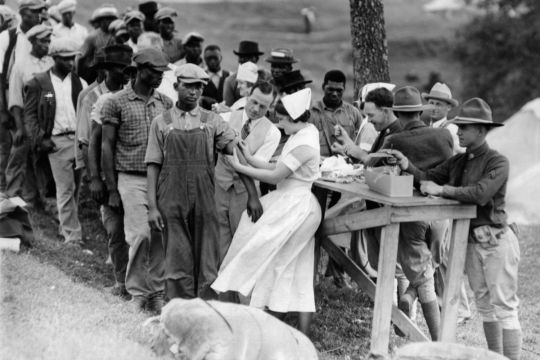
[Image ID: A black-and-white photograph of a group of Black people organized into two lines in a field. At the front of the two lines, there is a table and a few white people administering medical tests/attention to the Black people in the lines. End ID.]
Part of what sparked the Harlem Renaissance was a series of factors that compounded each other in the early part of the 1900s in America. Urbanization was one of these factors, and it describes the process of populations shifting from rural to city/urban environments. Early 1900s America saw a huge increase in the production of metal, the drilling for oil, and other industrial factors, which led to a large amount of skyscrapers being built and cities being developed.
Urbanization is not just the building of cities, though. It’s the population, economic, and cultural shifts that come with the building of cities. The environments people live in influence their financial situation, their culture, their education, and their access to certain resources and opportunities.
When mass urbanization happens, it’s usually accompanied by mass migrations, which is exactly what happened with what is now called the Great Migration, which lasted about 6 decades starting in 1910. The earlier part of the Great Migration was characterized by a huge amount of Black southerners migrating to the rapidly urbanizing North.
The Great Migration of Black people out of the South also coincided with a growth of new, revolutionary ideas about race and culture. The horrible legacy of white supremacy in America had completely severed Black Americans from their individual cultures in Africa. It caused, and continues to cause to this day, a difficulty for Black people to connect to cultural and racial pride- but in the early 1900s, that began to change.
A lot of Black people began striving to create racial pride out of the racial oppression they were experiencing- since many Black people didn’t know which culture they descended from, a movement to create the ‘New Negro’, as it was then called, out of a pan-African identity, began to grow. New, revolutionary ideas of what it meant to be Black in America- ideas rooted in pride and celebration rather than shame, took root as huge populations of Black people moved northward to growing cities.
In 1919, a series of deadly race riots, later known as ‘Red Summer’, combined with the renewed outrage many Black people had towards their inhumane treatment after experiencing much better treatment overseas at war, led to increased awareness of a racial reckoning in America, and the Harlem Renaissance was afoot.
The Harlem Renaissance-
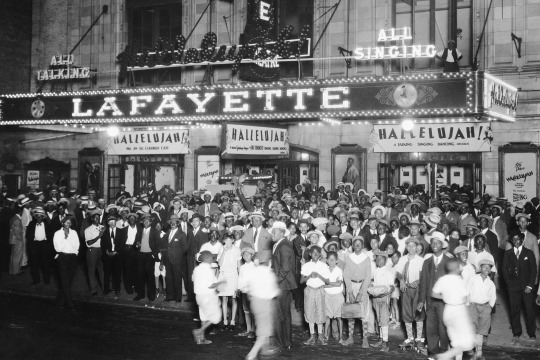
[Image ID: A black-and-white photograph of a large crowd of Black people all standing in front of a theater. The theater has a glitzy, light-up sign that says “LAFAYETTE” and is strewn with a few signs that say “HALLELUJAH!”. End ID.]
Centered in the city of Harlem in New York, the Harlem Renaissance was a Black cultural revolution. It was a national rebirth of Black pride and it involved the birth and growth of Black literature, art, music, culture, and pride.
Black music thrived through the international boom of jazz music. Black art and literature grew through publications like The Crisis and Opportunity. Black sociology thrived and defined the movement.
The Harlem Renaissance influenced the Civil Rights Movement, the Black Power movement, and all areas of Black culture, and it had and continues to have international influences.
Harlem buzzed with the opening of many new, ritzy clubs where people enjoyed vibrant performances, and Black night life became a staple of the Renaissance.
Visual Art During the Harlem Renaissance-

[Image ID: A colorful painting by Aaron Douglas. The background is vibrant streaks of golden, yellow, and orange, and the subject of the painting is a Black man in a brown suit, wearing a hat. End ID.]
Visual arts flourished during the Harlem Renaissance. Formal art education institutions were very hostile to Black people, so they very rarely could attend them, meaning that mainstream art movements ignored and excluded Black people, Black artists, and Black art. The Harlem Renaissance challenged that.
Often called the “Father of African-American Art”, the most famous visual artist of the Harlem Renaissance is Aaron Douglas. Influenced by movements like Cubism, Douglas had four of his works, a series which he called the “Aspects of N*gro Life”, commissioned. They became very popular for combining modern art styles with indigenous African styles mainly from West African countries, and they depicted Black people in different areas of life, especially music and other movements which flourished during the Harlem Renaissance.
Considered to be the first Pan-African-American artwork, a sculpture called ‘Ethiopia’ was created inspired by Egyptian culture by artist Meta Warrick Fuller, who made the art dedicated to the contributions of Black Americans to the world of art. Printmaking also flourished as an art form during the Harlem Renaissance with artists like James Lesesne Wells, whose style combined both European and African influences.
Photography helped sustain the Harlem Renaissance- historically, documentation of Black experiences had only been about pain and suffering- and while remembering those experiences is important, they are not the whole story. Famous photographer James Van Der Zee captured never-before-seen Black joy, Black pride, in his thousands of beautiful photographs of the Harlem Renaissance.
Theater During the Harlem Renaissance-
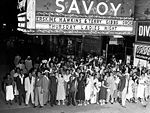
[Image ID: A small, blurry, black-and-white photograph of a large crowd of Black people standing and cheering outside of a theater called the Savoy Ballroom, which has a big, lit sign advertising its name and shows names of shows playing there beneath that sign. End ID.]
In media like plays and stage performances, Black identity had always been extremely limited- racist legacies of minstrel shows and racist stereotypes in performances meant that Black people were only ever portrayed in horribly demeaning roles, usually not even by Black actors, and when they WERE portrayed by Black actors, those actors were treated terribly and were forced to demean themselves in their performances.
The Harlem Renaissance began to challenge that by giving Black Americans the opportunity to represent themselves in their own stage performances- instead of the minstrel stereotypes they’d been reduced to for a long time, many began writing their own roles, allowing themselves to give depth and humanity to Black characters, allowing Black characters to be the good guys, allowing them the ability to have complex stories and lives outside of stereotypes.
Black Americans established such famous theaters as the Savoy Ballroom and the Apollo Theater, eventually becoming just south-adjacent of the white-dominated Broadway. Famous writers like Langston Hughes began writing plays like ‘Mulatto’ and ‘The Sun Do Move’, and famous Black actors like Billy King and Theophilus Lewis became stars.
One of the most influential stage works to come out of the Harlem Renaissance was a play called Shuffle Along, and it challenged the racist exclusion that many Black actors faced on Broadway by becoming the first Black play in over a decade to reach Broadway. It portrayed Black people living their lives and gave them the ability to express the humanity that white Americans were trying to ignore.
Sources-
https://magazine.artland.com/art-movement-harlem-renaissance/#:~:text=The%20Visual%20Arts%20of%20the%20Harlem%20Renaissance&text=Douglas%20was%20influenced%20by%20modernist,from%20Benin%2C%20Congo%20and%20Senegal.
https://www.britannica.com/event/Harlem-Renaissance-American-literature-and-art/Visual-art
https://macaulay.cuny.edu/seminars/henken08/articles/r/e/n/Renaissance_and_Theatre_d0e4.html#:~:text=These%20performances%20were%20often%20shown,and%20The%20Sun%20Do%20Move.
https://historyoftheharlemrenaissance.weebly.com/the-apollo-theatre.html https://www.history.com/topics/roaring-twenties/harlem-renaissance
tagging @metalheadsforblacklivesmatter @neopronouns @genderkoolaid
47 notes
·
View notes
Text




Amongst some of the proposals for a second Trump Admin:
- end surrogacy
- end no fault divorce
- invoke the insurrection act to stop protests
- end sex education in schools
- stop policies that “subsidize single motherhood”
#Donald Trump#Trump#2024 elections#politics#US politics#christian nationalism#fascisim#abortion#bodily autonomy
271 notes
·
View notes
Text
Becks Backstory - Silvia
What started out as an attempt for me to keep things straight in my head turned into a series of short stories centered around Becks and her backstory, which quickly became her backstories given how many years she's lived and how many names and personalities she's adopted. Some are complete, some aren't, I'll update as I go, yadda yadda.
So. This is Silvia. She's the sixth name/personality Becks created. She's a bit more tame than Fiadris, slightly more reserved and a bit more broken. Doesn't let it stop her from being playful, even if that playfulness is a tiny bit more withdrawn.
WC 1,386
-----------------------------------
–Late 1700s, America, hidden in the woods somewhere probably in the Northwest–
Silvia poked her head around a corner. William was huddled over his books, like always, small globs of magic light hanging over him while he studied. It was late into the night, but both Temerous and William were still awake.
Nevertheless, Silvia crept up on him. Barefoot as always, her clothes shuffling just the slightest as she moved. He was deep in thought this time, and she managed to summon a few vines to quietly creep along the wall, waiting until the right moment for them to reach out and slap his book away from him.
He startled and looked up and around as the book flew, Silvia catching it with a laugh.
“Gotcha!” she laughed as he turned with a frown.
“Silvia!!” he muttered, getting up and glancing around. “Give that back!!”
“What is it!?” she asked, sticking a hand out to stop him and looking at the page the book was opened to. Turned it this way and that. “These are sigils. Why are you working on sigils? I thought Temerous had you working on species classification.”
He tried to reach around her arm but was failing, her arms and vines moving to keep him at a distance while she ducked and wove around his grip when he managed to get past her blockers. “I– I don’t– Temerous just swapped lessons on me, I don’t– Silvia, come on, he’ll have my head if I don’t– Silvia–! Angel!!”
She stopped at that and looked at him, head tilted. He sighed and held his hand out. “Please, angel?”
She smiled. It had been a few years, and she still wasn’t tired of him calling her that. So she gave him the book back with a grand flourish, dropping it into his hands. “What is it?” she asked again, as he shuffled the pages back to the ones he had been reading.
“Temerous’ latest research,” he said, walking back to his desk and renewing the magic orbs of light. “He says something is going to happen soon and we’ll need to be ready…although what, exactly, is going to happen is something he won’t say. Just that we need to be ready.”
“Ready for what?” she asked. “How?”
William gave her an exasperated look but it cut off with a smile. “I don’t know, dummy. Temerous wouldn’t tell me.” He pointed to the book and his notes with a stick he was using to make the notes. “But he’s trying to find a way to combine these sigils here, see? Thinks he can make a way to separate a mage from their magic, just for a little while.”
“What? Why would he need to do that?”
William shrugged. “You’d have to go ask him,” he said, turning back to his work and tilting his head. “He’s really obsessed about it, though. As if this stuff is–” His voice cut off as it drifted away, Silvia already bounding down the hall and away. He called out after her and asked her to come back, but this time no amount of calling her angel would get her to cooperate. She was curious now, and if Temerous was the one to ask, that’s where she was going to go.
She found him where she always found him this hour of night. In his room, with the fireplace lit and staring into it. It had been years and she didn’t quite get the hang of this one; some days he acted like he was her age. And some days he acted like a bitter old codger that snapped at William and spent long hours staring into the fire.
Looks like tonight was a codger night. Not that she minded. He seemed to have a soft spot for her; never yelled, never hit, never threw things. Sometimes wasn’t always forthcoming with information, but never in a way that seemed like he was hiding something from her.
“Temerous…?” She called out, standing by his door. Peeking around the corner and waiting with her head tilted. “...Temerous?”
“...what is it?” he sighed, staring into the fire. “What’s gone wrong now…?”
She shook her head. “Nothing. Nothing wrong really. I just…” she hesitated. Tilted her head. “Why do you like the fire?”
“I find it soothing,” he answered absently. “Reminds me of…simpler days.”
She stared at the fire too, then, watching it dance and flicker against the stonework of the fireplace. Found her own memories flickering within…memories of something long lost. Long forgotten. Days when the fire was almost alive…Silvia stepped up to it slowly, watching it flicker and almost reach out to her. Like an old friend…like someone inviting her to play. She couldn’t quite place it…not anymore. But she knew that fire was once her friend, a playmate and companion.
She didn’t realize she had reached out for it until a firm grip wrapped around her wrist. She flinched and looked up, seeing Temerous staring at her.
“Don’t hurt me,” she whispered, tugging at her hand as she began to panic. “Don’t–”
The grip was gone, then, Temerous sitting back as a sad look came across his face. He’d never done anything to hurt her before. He hadn’t done anything to hurt her now. She rubbed at her wrist and stared at him, wondering why she’d said that. Wondering why he looked so sad all of the sudden.
“Don’t reach into the fire,” he sighed. “You’ll burn yourself.”
She shook her head. “It wouldn’t hurt me.”
“It’s not what you think it is,” he answered, reaching around to grab a long piece of sharp metal that he used to poke at it. “It’s not alive.”
“Of course it is,” she said, looking back. “You feed it coal and wood. You give it a space to breathe. You give it a home, shelter from that which would hurt it. Watch over it as it dances. Watch it until it sleeps, and then bring it back to life the next night.” She looked back at him. “How is that not alive?”
He stared at her with a slight frown, consideration now entering his gaze. A small smile cracked his features and he let out a snort. “I suppose, when you put it that way, the fire does sound alive. Quite alive indeed.” He put his hands in his lap and gave her a wider smile. “Now, young half-sprite. What can I do for you?”
She blinked. Oh right. “Why did you have William switch from species categorization to sigil work?”
“Because I need him to learn about it,” he said simply. “Why else would I switch him from one subject to another?”
“Why?”
“I’m working on a new project and I don’t want him to be caught out in ignorance.”
“Why?”
He heaved a small sigh and shook his head. “Never you mind why. How is your garden coming along?”
She tilted her head and looked at him with a frown. “I managed to grow some of the things you suggested. Some of the plants don’t seem to like it here.”
“Give them time. I’m sure they’ll come around.”
“William said you said something was going to happen. What’s going to happen?”
He stared at her. “Many, many things.” His voice drifted as he spoke, like he was looking at her and looking past her. Seeing something that she couldn’t understand. “So much is going to happen, little half-sprite,” he said, his voice dropping to a near whisper. “And you must be ready for it all.”
Then just as suddenly he roused himself, poked at the fire, and stood. “Come now, Silvia,” he said, flashing her a smile. “Let see if we can’t convince a few extra plants to make a home here.”
She was confused at the shift in his energy and mood, but that wasn’t anything new. He did things like this all the time, seeming to see her and see something else when he looked at her. Not like when Bran used to look at her, not nearly as off-putting. The look in Termerous’ eyes never gave her any suspicion or fear. And yet…
He shuffled her from the room, encouraging her to leave and following her quickly, getting her to race out to her garden despite the late hour.
27 notes
·
View notes
Text
Solarpunk Gives Me Hope
For the past couple of years, I’ve been really interested in the solarpunk genre. Up until now, it’s been a flirtatious relationship, but I’m ready to settle down. Sustainability and Environmentalism have been a big part of my adult life; I always knew that I wanted to have a positive impact on the world at large, and what better way to do that than to put time into preserving that very world? However, as I got deeper into the sustainability space, I saw a lot of reductive, holier-than-thou behavior and apathy toward meaningful action. Like, recycling is great (if it actually gets recycled, thanks America), but is that it? Is that all we can do? Environmentalism as a movement also has a history steeped in white supremacy, a trend that is bubbling up again.
As you can tell, I got really frustrated with the landscape of the environmental movement. I never heard anyone acknowledge the issues that exist on both sides of the aisle; there didn’t seem to be a lot of care for the people that are most vulnerable to climate change in those conversations. It led me to move away from the sustainability space, wholesale. I didn’t really understand why until I discovered solarpunk. Hearing about this subgenre-meets-movement lit the fire in my heart. Solarpunk represents what I think is the most exciting way to think about not only saving our planet but saving ourselves.
What is Solarpunk?
People have their own definitions for solarpunk, which is as liberating as it is frustrating. One of the best ones that I found came from Solarpunk Rising. Their definition is for solarpunk is “a creative movement that encourages optimistic visions of the future while responding to the climate crisis as well as social inequality”. I’d like to crib off of that one to explain how I think of solarpunk: “a creative movement that combines Art, Sustainability, and Social Liberation with an optimistic lens. It helps us imagine the world we want to see so we can create it.”
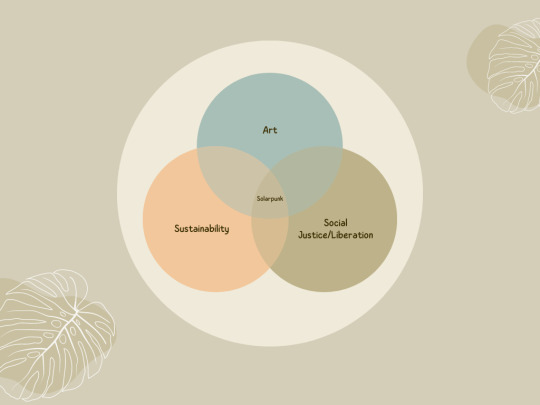
I don’t think it’s super useful to gatekeep what is and isn’t solarpunk beyond this definition. It is important, however, to highlight the liberatory, social aspects of solarpunk. While it’s fine and dandy to see solarpunk as a cool aesthetic, the real power comes from the real-life, tangible impacts that the movement can have.
Some things that I’d consider to be solarpunk actions in real life:
Proposing legislation to your local government to prioritize walkability in new developments
Writing articles about DIY ways to lessen your reliance on big corporations
Seed bombing an empty plot of land with native species
Airdropping anti-fascist memes to people in public
Solarpunk to me is any activity that centers a genuine excitement for how the world can be with an action-oriented approach.
Connected ideologies
Solarpunk has a lot of compatible ideologies, some of which you may have picked up on already. Just to list some important ones:
DIY: Being able to lessen your own consumption by fixing and repairing/repurposing what you have is super solarpunk
Optimism: It’s hard to imagine a better world if you don’t believe the world can get better. Solarpunk positions being an optimist as the most punk thing you can do in a world that feels made to keep you down.
Renewables (a la Solar): Surprise suprise, solarpunks tend to be into solar! One of the biggest harms to our planet is our relationship with energy. While trying to lessen the total amount of energy we use, we must also replace nonrenewable energy forms with those that are replenishable. Our amount of appropriation of resources can’t continue to exceed nature’s ability to replenish those resources.
Sustainability: Tying into the above ideal, across all facets of society, sustainability should be the goal. We should be able to find a sustainable level of interaction with the environment, with our consumption and lifestyles, and our systems of governance.
Liberation: None of this work would be worth it if our sparkly new world was built on oppressive practices. Centering equity as the lens though which we do all of the above work will give us much more in return.
Conclusion
Before I go, I want to mention lunarpunk. Where solarpunk is yin, lunarpunk is yang. They can be seen as two differing halves of a greater whole, focused on different aspects of their utopic goals. Solarpunk stuff will mostly be focused on tech, while lunarpunk is much more likely to include fantastical, occult, or spiritual ideals. I’m not as well versed on that, so I’m not going to go too deep, but I think it’s worth mentioning, as it’ll probably come up in your research.
I hope this was somewhat interesting to you! I really am jazzed about this world of solarpunk and find the ability of fiction to be a tool for creating the future. It can be in negative, dystopic ways, sure, but I feel like the positive outcomes are also ripe for the taking! I hope that you’re interested in exploring more, as I’ll have some links listed below: my inspirations for this post, along with my list of cool solarpunk stuff that I am constantly updating. Hopefully, we can dream of better futures together!
Sources
A Solarpunk Manifesto (English) – ReDes – Regenerative Design. https://www.re-des.org/a-solarpunk-manifesto/. Accessed 23 Nov. 2022.
Andrewism. How Degrowth Can Save The World. 2022. YouTube, https://www.youtube.com/watch?v=oQrI2GBvn5Q.
How We Can Build A Solarpunk Future (Ft. @Our Changing Climate). 2022. YouTube, https://www.youtube.com/watch?v=Rz51PkJy2c0.
How We Can Make Solarpunk A Reality (Ft. @Our Changing Climate). 2021. YouTube, https://www.youtube.com/watch?v=u-JvyfZVkIM.
Humanity Is Not A Parasite. 2022. YouTube, https://www.youtube.com/watch?v=j42RbUjofm0.
Solarpunk Is Not Enough. 2021. YouTube, https://www.youtube.com/watch?v=rKaSb2gi1Ew.
We Need A Library Economy. 2022. YouTube, https://www.youtube.com/watch?v=NOYa3YzVtyk.
What Is Solarpunk? 2020. YouTube, https://www.youtube.com/watch?v=hHI61GHNGJM.
meningeal. “New to Solarpunk? Start Here!” R/Solarpunk, 13 June 2022, www.reddit.com/r/solarpunk/comments/vb1ky1/new_to_solarpunk_start_here/.
Our Changing Climate. How We Can Build A Solarpunk Future Right Now (Ft. @Andrewism). 2022. YouTube, https://www.youtube.com/watch?v=twGcjDnOb_U.
Why This Gives Me Hope for the Future (Ft. @Saint Andrewism). 2021. YouTube, https://www.youtube.com/watch?v=u3aauiR9M88.
Reina-Rozo, Juan David. “Art, Energy and Technology: The Solarpunk Movement.” International Journal of Engineering, Social Justice, and Peace, vol. 8, no. 1, 1, Mar. 2021, pp. 47–60. ojs.library.queensu.ca, https://doi.org/10.24908/ijesjp.v8i1.14292.
“Solarpunk.” Wikipedia, 29 Nov. 2022. Wikipedia, https://en.wikipedia.org/w/index.php?title=Solarpunk&oldid=1124508051.
“Solarpunk: A Genre of Activism.” Solarpunk Magazine, 13 Oct. 2021, https://solarpunkmagazine.com/solarpunk-a-genre-of-activism/.
Solarpunk.fun, Team. “Evergreen: Basically, Solarpunk.” SolarPunk, 25 Mar. 2021, https://www.solarpunk.fun/2021/03/25/basically-solarpunk/.
Solarpunk Reading List
63 notes
·
View notes
Text
As he campaigns for a second White House term, Trump has been asking policy advisersfor a range of military options aimed at taking on Mexican drug cartels, including strikes that are not sanctioned by Mexico’s government, according to two sources familiar with the situation.
“‘Attacking Mexico,’ or whatever you’d like to call it, is something that President Trump has said he wants ‘battle plans’ drawn for,” says one of the sources. “He’s complained about missed opportunities of his first term, and there are a lot of people around him who want fewer missed opportunities in a second Trump presidency.”
Trump lieutenants have briefed him on several options that include unilateral military strikes and troop deployments on a sovereign U.S. partner and neighbor, the sources say. One such proposal that Trump has been briefed on this year is an October white paper from the Center for Renewing America, an increasingly influential think tank staffed largely by Trumpist wonks, MAGA loyalists, and veterans of his administration.
See you all in hell or a FEMA camp
50 notes
·
View notes